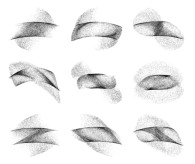Beautiful plots while simulating loss in two-part procrustes problem
 Today I was working on a two-part procrustes problem and wanted to find out why my minimization algorithm sometimes does not converge properly or renders unexpected results. The loss function to be minimized is
Today I was working on a two-part procrustes problem and wanted to find out why my minimization algorithm sometimes does not converge properly or renders unexpected results. The loss function to be minimized is
with denoting the Frobenius norm,
is an unknown scalar and
an unknown rotation matrix, i.e.
.
, and
are four real valued matrices. The minimum for
is easily found by setting the partial derivation of
w.r.t
equal to zero.
By plugging into the loss function
we get a new loss function
that only depends on
. This is the starting situation.
When trying to find out why the algorithm to minimize did not work as expected, I got stuck. So I decided to conduct a small simulation and generate random rotation matrices to study the relation between the parameter
and the value of the loss function
. Before looking at the results for the entire two-part procrustes problem from above, let’s visualize the results for the first part of the loss function only, i.e.
Here, has the same minimum as for the whole formula above. For the simulation I used
as input matrices. Generating many random rotation matrices and plotting
against the value of the loss function yields the following plot.

This is a well behaved relation, for each scaling parameter the loss is identical. Now let’s look at the full two-part loss function. As input matrices I used
and the following R-code.
# trace function
tr <- function(X) sum(diag(X))
# random matrix type 1
rmat_1 <- function(n=3, p=3, min=-1, max=1){
matrix(runif(n*p, min, max), ncol=p)
}
# random matrix type 2, sparse
rmat_2 <- function(p=3) {
diag(p)[, sample(1:p, p)]
}
# generate random rotation matrix Q. Based on Q find
# optimal scaling factor c and calculate loss function value
#
one_sample <- function(n=2, p=2)
{
Q <- mixAK::rRotationMatrix(n=1, dim=p) %*% # random rotation matrix det(Q) = 1
diag(sample(c(-1,1), p, rep=T)) # additional reflections, so det(Q) in {-1,1}
s <- tr( t(Q) %*% t(A1) %*% B1 ) / norm(A1, "F")^2 # scaling factor c
rss <- norm(s*A1 %*% Q - B1, "F")^2 + # get residual sum of squares
norm(A2 %*% Q - B2, "F")^2
c(s=s, rss=rss)
}
# find c and rss or many random rotation matrices
#
set.seed(10) # nice case for 3 x 3
n <- 3
p <- 3
A1 <- round(rmat_1(n, p), 1)
B1 <- round(rmat_1(n, p), 1)
A2 <- rmat_2(p)
B2 <- rmat_2(p)
x <- plyr::rdply(40000, one_sample(3,3))
plot(x$s, x$rss, pch=16, cex=.4, xlab="c", ylab="L(Q)", col="#00000010")
This time the result turns out to be very different and … beautiful :)

Here, we do not have a one to one relation between the scaling parameter and the loss function any more. I do not quite know what to make of this yet. But for now I am happy that it has aestethic value. Below you find some more beautiful graphics with different matrices as inputs.

Cheers!
Filed under: R / R-Code | 4 Comments
 All postings
All postings


Hi Mark, I try to run your syntax but R returns an error: could not find function “rdply”
So, probably one or more packages are required. If so, which are these?
Regards,
Eric
Hi Eric, you must load the ‘plyr’ package. I fixed it in the code. Thanks.
Hi Mark, I’m Brand new to R and just started blogging about it as well to help me remember/learn it. Thanks for your blog. Is there a contact page on your wordpress site? I couldn’t find one.
I found you R Google search blog incredibly helpful, and had a question, but i think the comments were closed. https://ryouready.wordpress.com/2009/01/01/r-retrieving-information-from-google-with-rcurl-package/.
I recently used it to grab all locations of a particular company across the US. I was curious if there was way to get to page 2 of Google using that code?
Thanks again,
Hi,
glad that you like the site:) Concerning Google, you can pass the ‘start’ parameter in the GET request, e.g. ‘start=10’ to get the second page. If you are not familiaer with the structure of GET requests, you may want to read about that first..
HTH
Bests
Mark